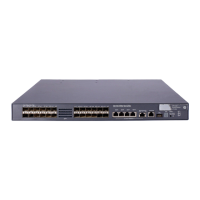184
To do... Use the command... Remarks
3. Configure an SVLAN as the
match criterion
if-match service-vlan-id vlan-id
4. Return to system view
quit
Repeat these steps to configure
one class for each SVLAN.
5. Create a traffic behavior and
enter traffic behavior view
traffic behavior behavior-name
6. Configure a CVLAN marking
action
remark customer-vlan-id vlan-id
7. Return to system view
quit
Required.
Repeat these steps to configure a
behavior for each CVLAN.
8. Create a QoS policy and
enter QoS policy view
qos policy policy-name Required.
9. Associate the class with the
behavior to map the SVLAN
to the CVLAN
classifier tcl-name behavior
behavior-name
Required.
Repeat these steps to create other
CVLAN-to-SVLAN mappings.
Configuring the customer-side port
To configure the customer-side port:
To do... Use the command... Remarks
1. Enter system view
system-view —
2. Enter Layer 2 Ethernet
interface view
interface interface-type interface-
number
—
3. Configure the port as a trunk
port
port link-type trunk
Required.
The default link type of an
Ethernet port is access.
4. Assign the port to CVLANs
and SVLANs
port trunk permit vlan { vlan-id-list
| all }
Required.
By default, a trunk port is in only
VLAN 1.
5. Enable basic QinQ
qinq enable
Required.
By default, basic QinQ is
disabled.
6. Apply the uplink policy to the
incoming traffic
qos apply policy policy-name
inbound
Required.
7. Apply the downlink policy to
the outgoing traffic
qos apply policy policy-name
outbound
Required.
Configuring the network-side port
To configure the network-side port:
To do... Use the command... Remarks
1. Enter system view
system-view —
2. Enter Layer 2 Ethernet interface view
interface interface-type interface-
number
—

